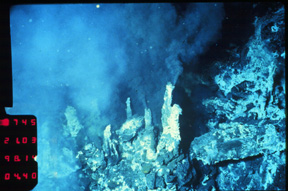
Hydrothermal vents and new forms of life were first discovered at mid-ocean ridges in 1977. Hydrothermal vents, also called black smokers, have been discovered at nearly all the mid-ocean ridges. Water, hydrogen sulfide, and other minerals pour from these springs at temperatures of about 660 degrees F (350 degrees C). These hot waters host an ecosystem complete with giant clams, mussels, tube worms, and other critters. These organisms use sulfur, not sunlight, to live. Photograph of a tube worm colony by Daniel Fornari, Woods Hole Oceanographic Institution. Photo from U.S. Geological Survey's This Dynamic Earth.

The vents for the hydrothermal fluids are called black smokers because they produce black "chimney stacks." The stacks are made of iron and zinc sulfide minerals and calcium sulfate. The chimney stacks can grow to heights of about 40 feet (13 m) but most are less than 30 feet (10m) tall. The diameters of the chimneys range from less than an inch (1 cm) to 12 inches (30 cm). This photo shows recently formed hydrothermal vents in the axial summit collapse trough of the East Pacific Rise near 9 degrees 50'N just following the 1991 submarine eruption. Photography courtesy of Woods Hole Oceanographic Institution and members of the Adventure dive (Principle Investigators: D. Fornari, R. Haymon, K. Von Damm, M. Perfit, M. Lilley, and R. Lutz).

Argo I photograph of hydrothermal community in summit trough of East Pacific Rise crest near 9 degrees 51'N.

Tubeworms on large lava pillar in the floor of the axial summit collapse
trough of the East Pacific Rise near 9 degrees 49.6'N, 2513m depth.

Black smoker hydrothermal vent at Lucky Strike Seamount,
Mid-Atlantic Ridge near 37 degrees 18'N at 1700m depth.